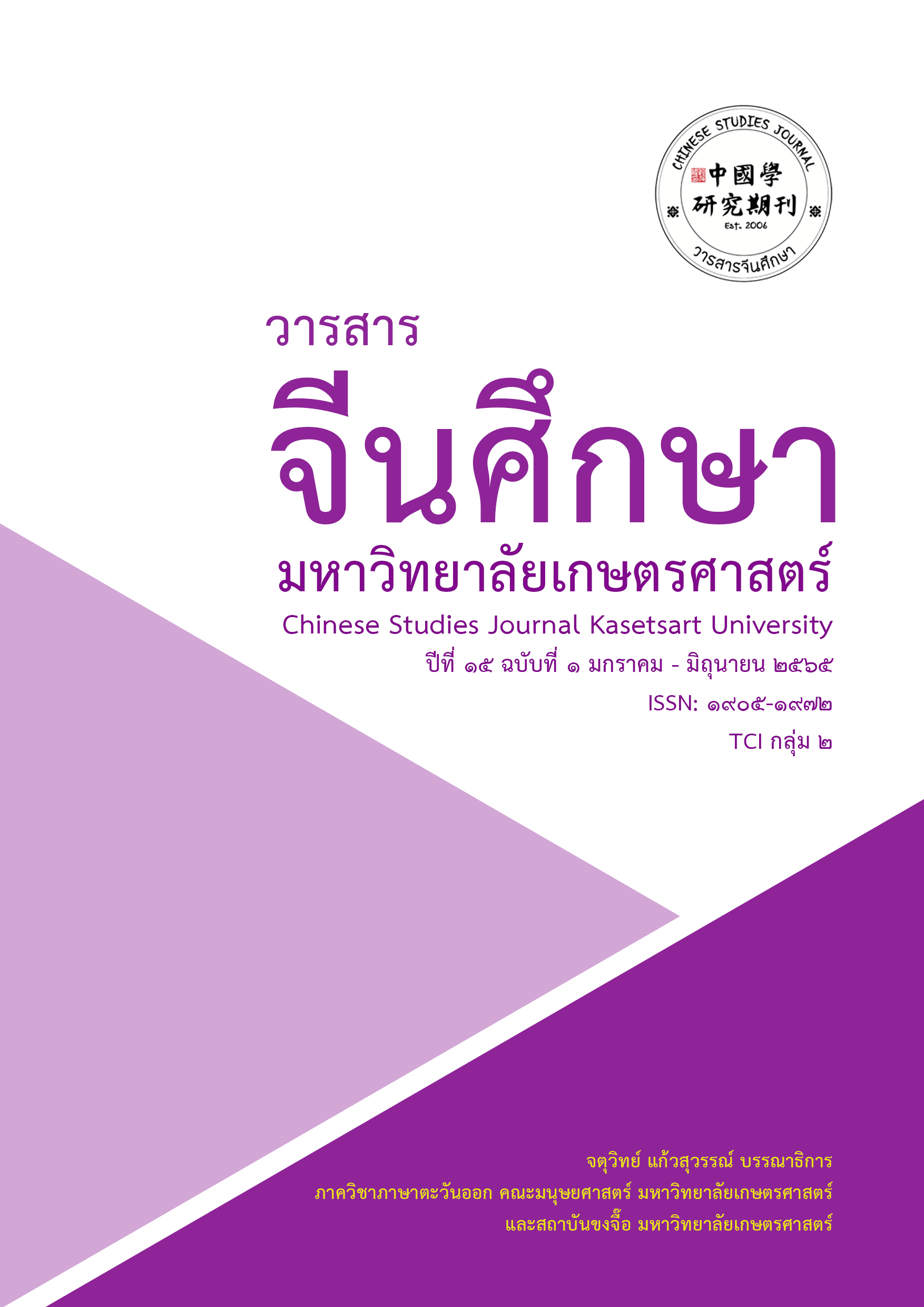Definition, Taxonomy and Governance on Irregular Migrant Workers: The Cases in Lancang-Mekong Subregion แนวทางการจัดการการกำหนดและจำแนกสถานะของแรงงานอพยพที่ไม่เป็นไปตามกฎเกณฑ์: กรณีศึกษาอนุภูมิภาคแม่น้ำล้านช้าง-แม่น้ำโขง
Main Article Content
Abstract
For a long time, irregular migrant workers have been placed as a sort of immigrant group that poses hard to be identified due to the problematic controversary of definition as well as taxonomy regarding such a grand migration wave. Defining the nature, characteristics and scope of irregular migrant workers in the destination country scheme will help the country to deploy more reasonable governance strategies as well as effectively protect the rights of irregular migrant workers, especially the vulnerable groups among them. This paper analyzes the behavioral rules of irregular migrant workers under migration theories and qualitative research methods, then embeds the two sorts of hypothetical taxonomies of A and B migrant groups into the case analysis of Lancang-Mekong subregion, with the purpose of figuring out the sophisticated phenomenon of irregular migration between six countries in the subregion. Based on above, several suggestions on governing are proposed respectively.
Article Details

This work is licensed under a Creative Commons Attribution-NonCommercial-NoDerivatives 4.0 International License.
ผลงานทางวิชาการที่ลงตีพิมพ์ในวารสารจีนศึกษา มหาวิทยาลัยเกษตรศาสตร์ เป็นลิขสิทธิ์ของผู้เขียนหรือผู้แปลผลงานนั้น หากนำลงในวารสารจีนศึกษาเป็นครั้งแรก เจ้าของผลงานสามารถนำไปตีพิมพ์ซ้ำในวารสารหรือหนังสืออื่นได้โดยมิต้องแจ้งให้ทราบล่วงหน้า แต่หากผลงานที่ได้รับพิจารณานำลงในวารสารจีนศึกษา เป็นผลงานที่เคยตีพิมพ์ที่อื่นมาก่อนเจ้าของผลงานต้องจัดการเรื่องปัญหาลิขสิทธิ์กับแหล่งพิมพ์แรกเอง หากเกิดปัญหาทางกฎหมาย ถือว่าไม่อยู่ในความรับผิดชอบของวารสารจีนศึกษา มหาวิทยาลัยเกษตรศาสตร์ ทั้งนี้ ความคิดเห็นต่างๆ ในบทความเป็นความคิดเห็นส่วนตัวของผู้เขียน ไม่เกี่ยวกับกองบรรณาธิการวารสารจีนศึกษา มหาวิทยาลัยเกษตรศาสตร์
References
但伟.(2004).偷渡犯罪比较研究(第四版).北京: 法律出版社.
孔令杰.(2013).中老缅泰湄公河流域联合执法的法律基础与制度建构. 东南亚研究,(3),6.
李其荣.(2003).经济全球化与国际人口迁移.民族研究,(6),12.
李其荣.(2014).全球化时代的人口迁移与政策研究. 学术前沿,(8),14.
李国梁,潘敏仪.(2018).越南劳工跨境非法就业的治理对策——以崇左市为例.现代商贸工业,39(9),5.
卢光盛.(2016).澜沧江—湄公河合作机制与跨境安全治理.南洋问题研究, (3),11.
黎尔平.(2006).大湄公河次区域经济合作政治信任度研究.东南亚研究,(5),5.
澜湄合作网.(2016).澜沧江-湄公河合作首次领导人会议《三亚宣言》. Retrieved from http://www.lmcchina.org/zywj/t1511256.htm
澜湄执法安全合作中心.(2020).澜湄地区国家打击跨境人口拐卖联合行动召开总结会.Retrievd from http://www.lm-lesc-center.org /Pages_15_4587.aspx
尚子娟, 刘泽.(2019).中国性别失衡背景下婚姻挤压问题的治理研究——基于“越南新娘”现象的思考. 武汉科技大学学报:社会科学版,21(6), 5.
吴琳.(2017).东南亚移民危机与移民治理: 从安全化到区域化.东南亚 研究,(5),20.
王辉耀,刘国福.(2012).在华非常规移民.北京:社会科学文献出版社,258.
向党.(2013).2012年《出入境管理法》的缺陷与不足.第四届移民法论坛: 出入境管理法、中国与世界论文集, 76-83.
许红艳.(2013).大湄公河次区域劳工移民研究.东南亚纵横,(4),6.
徐军华.(2007).非法移民的法律控制问题.武汉:华中科技大学版社 .
俞可平.(2002).全球治理引论.马克思主义与现实, (1).
张洁,梁劲.(2020).新冠疫情凸显东南亚外籍劳工多重困境.世界知识,(15), 2.
张洁.(2017).中国构建周边安全形势评估(2017):大国关系与地区秩序. 北京:社会科学文献出版社,183.
张戈跃,郭宵星.(2017).中越边境越南居民在广西提供跨境劳务的现状及改善途径.对外经贸实务,(6),4.
张林.(2005).澜沧江—湄公河次区域合作的制度主义观.当代亚太, (10),4.
中国国家统计局.(2011).全国各省2011GDP.Retriedved from http://data.stats.gov.cn/search.htm?s=全国各省2011GDP
中国国家移民管理局.(2019).2009年出入境边防检查机关检查综合统计 数据.Retreived from https://www.nia.gov.cn/n 741440 /n741567/c1176194/content.html
Alice B., Milena C. (2011). Irregular Migration in a Globalizing World. Ethnic and Racial Studies, 34(8), 1271-1285.
Cholewinski R. (2015). Migration for Employment. Netherlands, Leiden: Brill.
Chantavanich, S. (2020). Thailand’s Challenges in Implementing Anti-trafficking Legislation: The Case of the Rohingya. Palermo at 20: A Retrospective and Prospective. Special issue of the Journal of Human Trafficking, 06(02), 234-243.
International Labour Migration.(2010). A Rights-based Approach. Switzerland, Geneva: ILO Office.
International Labour Organization. (2021). ILO Monitor: COVID-19 and the World of Work. 7th-Edition. Switzerland, Geneva: ILO OFFICE.
International Migration Organizastion. (n.d.). Key Migration Terms. Retrieved from https://www.iom.int/key-migration-terms#Irregular-migration.
International Labour Organizastion. (n.d.). Normlexs. Retrieved from https://www.ilo.org/dyn/normlex/en/f?p=1000:12000:::NO:::.
Milena C., John S. (2011). Social Movements of Irregular Migrants, Recognition and Citizenship. Globalizations, 08(03), 343-360.
Mekong Migration Network. (2017). Annual Report 2017. Thailand, Chiangmai: MMN.
Mekong Migration Network and Asian Migrant Centre. (2009). Migration in the Greater Mekong Subregion Annotated Bibliography (Fourth Edition). China, Hong Kong: Clear-Cut Publishing & Printing Co.
Max T. and Benjamin H. (2018). Addressing Irregular Migration and Violation of Migrant Worker. Safeguarding the Rights of Asian Migrant Workers from Home to the Workplace. Philipines, Manila: ADB, OECD and ILO.
Network European Migration. (2011). Practical Measures to Reduce Irregular Migration. Belgium, Brussel: EMN Publications Office.
Organization of Economic Co-operation and Development. (2010). International Migration Out-look: SOPEMI 2010. France, Paris: OECD.
Robert O. Keohane, Joseph S. Nye. (1997). Power and Interdependence: World Politics in Transition. The United Nations of America, Boston: Little, Brown.
The United Nations Department of Economic and Social Affairs. (2008). Trends in International Migrant Stock: The 2008 Revision. The United Nations of America, New York: UNDESA.
The United Nations Department of Economic and Social Affairs. (2017). World
Population Prospects: The 2017 Revision. The United States of America, New York: UNDESA.
United Nation in Thailand. (2009). Thailand Migration Report 2019. Thailand, Bangkok: UN in Thailand.
Vogel, D. (2014). Update report Germany: Estimated Number of Irregular Foreign Residents in Germany. Retieved from https://irregular-migration.net/wp-content/uploads/2021/06/Vogel_2015_Update_report_Germany_2014_fin-.pdf.
Vogel, D., Aßner, M. (2014). Umfang, Entwicklung und Struktur der Irregulären Bevölkerung in Deutschland. Retrieved from https://www.bamf.de/SharedDocs/Anlagen/DE/EMN/Studien/ZuStudien/emnwp41expertise.pdf?__blob=publicationFile&v=17.
Walsh J. Makararavy T. (2011). Cambodian Migrants in Thailand: Working Condition and Issues. Asian Social Science, 07(07), 23.


